
Atlas F1 Technical Writer
The break between the San Marino Grand Prix and the upcoming one in Spain saw all eleven teams test simultaneously for the first time since the beginning of the season. Some new parts were seen on the cars, but the overall sorting order of the grid should not see much changes in the fifth race of the season. Craig Scarborough looks ahead at this weekend's venue and players
The Circuit de Catalunya is situated near Barcelona and the track has a perfect layout for testing: a combination of fast and slow corners with a long pit straight that ends with a heavy braking area into turn one. The surface is bumpy and hard on tyres, which also aids testing. This layout also produces some great racing, as it provides close racing and a number of overtaking opportunities.
Set up and Layout
A lap of Barcelona with Jacques Villeneuve
"You start with a long straight, which is normally a good thing for racing, but you don't have a heavy braking point at the end of the straight here: you have short braking into Elf - a right left combination. It's a corner that you have to turn into early, so it doesn't leave much room to try and out-brake someone. It's not an easy combination.
"Out of that you go straight into Renault - a high-speed uphill right-hander. It's a blind corner so you don't really see it. The track falls away from you so the car gets light in the middle. It's a very difficult corner and also very fast.
"Then you have a quick tap on the brakes into the next corner, Repsol. It's a heavy braking area but short, with a very early turn in. As soon as you turn in the corner opens up, so you can always go faster than it appears visually. It is a very bouncy corner because there are a lot of ripples in the asphalt.
"Following Repsol there is a small acceleration into the Seat hairpin. There's nothing too special about it - it's just brake and turn and all downhill. Then you come to an interesting corner where the track drops as you turn in. The corner is slightly banked, and then at the apex the track starts to rise so the car gets pushed down. It's a corner that you can actually carry a lot of speed through but it's very difficult to get right. It's easy to lose a lot of time with the wrong set-up.
"After this you have a fun corner. You accelerate uphill and just at the top of the hill you don't actually have to brake - just a little lift in 4th or 5th gear for quite a quick right-hander, taken at around 200kmh. Campsa is an important corner as it gives speed on the back straight, which is another place where you can overtake, as there is a heavy braking point at the end of it into the slow La Caixa corner.
"Then you get into the last section of the track with the tight 2nd corner, which is quite slow. It's slightly quicker than the other hairpin, but still very slow. Then it's a short acceleration into a long right- hander. It's slow again but very long and it's quite a hard corner to get right.
"Finally, you come to the last 2 corners, which are both fun. The first chink, before the pit entrance, is almost flat out in 4th or 5th gear. Then the last corner is just a little lift before you get in, so it's also very fast. It's an exciting corner, as it's one of the few in F1 that actually feels fast and gives you speed into the straight."
The Spanish Grand Prix is an unusual event in that most teams have already run several race distances with their new cars on the track during testing. This means the teams arrive well prepared, but carry no advantage as all the other teams have the same experience. And, despite the huge amount of mileage the teams cover here in a season, it is still a favourite with the drivers.
The circuit tests every element of the car but aerodynamic efficiency is the major factor, and to balance grip on the slower sections against speed on the fast straights the cars will run a medium to high downforce configuration, as at Imola. Mechanically, the circuit demands good traction from the cars, as there are six-second gear corners. Brakes will be worked hard and large format brake ducts will be run. Imola also had similar braking demands, but the cooler weather left most of the teams running too large a duct - in qualifying most teams taped up their ducts to maintain brake temperature.
Its location on the Mediterranean means the temperatures remain warm to hot, but rain remains a possibility. One aspect of the weather that affects the race the most is the wind; the speed and direction of the wind varies throughout the course of the weekend leaving the teams chasing set up. Inconsistent wind direction causes problems with the aerodynamics - in a head wind a car will produce more downforce and vice versa with a tail wind - and the drivers are very sensitive to the changes, as the car will vary between understeer or oversteer.
With the circuit being so dependant on set-up, teams not predicting the wind changes can drop on their lap times. Another result of the circuit's demands on set-up is that the car will be the limiting factor in performance and hence most teammates will qualify alongside each other.
The circuit tests the reliability of the cars, as the bumpy surface affects mechanical and electronic systems. The surface also brings tyres into the equation - tyre wear and durability are major factors on race pace and strategy. While Michelin are expected to produce a strong race tyre, there still remains the question of the French tyre's performance in the more temperate environment. Cars that do not take care of their tyres will be punished in the race with extra pit stops. This year, with better tyres and developed aerodynamics and electronics, the pole time is expected to fall by almost 1.5 seconds, according to the Williams teams simulations.
Predicting the teams' competitiveness in Spain is a little easier coming after Imola, which has similar demands on the car. Furthermore, recent testing both in Barcelona and at Silverstone, while not a very accurate marker of pace, suggests the teams will be close at the front.
Ferrari has a number of developments to the new car for the race and the F2002 has proven to be faster than its predecessor and crucially kinder to its tyres. Williams are understating their expected competitiveness, but logic predicts they will be right up with Ferrari all weekend. McLaren have been working hard through a difficult period and this should be the track were they could hold an advantage - they have shown their best pace in testing here particularly in the hands of Kimi Raikkonen.
McLaren have tested almost exclusively at Spanish tracks this year, but they are still expected to be behind the first two teams, although closer in pace than at previous events. Renault's season is building up momentum, and they should expect to be right up with McLaren. The midfield and back markers are not expected to provide any major changes - reliability and race accidents will be the factor that shuffles their finishing order.
Tyres
After the success of the hot flyaway races and the widely predicted pace of the new Ferrari, Michelin are now facing the reality of the season. They have been working on their tyre development relentlessly, with all of their teams dedicating large amounts of last week's test session to tyre testing. Michelin have two all new compounds specifically for the race.
As for Bridgestone, the Japanese tyre maker hadn't confirmed what tyres would be brought to Spain, but it should be noted that every race this year has seen at least one new compound or construction.
BAR completed a major tyre test at Silverstone, complete with tyre temperature sensors attached to either side of the rear wing to monitor the behaviour across of the full width of the tyre through out the lap. This type of testing is becoming more common place in the tyre companies quest to understand what a modern F1 car requires from its tyres. With such a major test completed by the supplier's leading customer team, the other Bridgestone customer teams should find a performance improvement in Spain.
Team by Team
Ferrari
A dominant one-two finish for the team leading up to the Spanish race should leave Ferrari full of confidence, however there was a reliability worry for Michael Schumacher in the San Marino race, as a suspected problem with his steering wheel was reported. Moreover, the lower temperatures flattered the Bridgestone tyres and the F2002's cooling system. Going to the warmer race in Spain should eat into some of the advantage enjoyed in Italy.
Strategy is a strong card for the team, but again they have shown they need to stop earlier than others teams. When there is a performance advantage this is no problem, but should a Williams or McLaren be closely following a Ferrari leading up the pit stop window, the smaller range of the Ferrari fuel tank could be a handicap.
Ferrari returned to their preferred practice of testing away from the other teams last week, staying in Italy for tyre and set up testing, which included a test in Monza, in low downforce configuration. The circuit was modified with traffic cones to simulate a tight chicane, presumably in preparation for the Canadian race, where Williams are expected to have an advantage.
In Mugello, Michael Schumacher had a crash presumably resulting from a front suspension failure; this is following several rear suspension failures in testing earlier in the year.
Barcelona should see Ferrari as the team to set the pace. The F2002 works well in fast corners and Ferrari have often had an advantage in traction out of slow corners. Furthermore, the new car is easier on tyres, allowing Ferrari the option of running the softer tyre and not having to pit as often in the race.
Additionally, there is a new engine specification for the race providing more power. Rubens Barichello appears to be more comfortable in the new car and was matching Michael throughout the Imola weekend. This increased competitiveness from the Brazilian should see an equally close race this weekend.
Williams
Going to Imola, it was clear that Williams had to prove that they can match the pace of Ferrari on slower and cooler European circuits, but as the weekend progressed it was clear Ferrari had a considerable advantage. The team were reflective after the race that brought third and fourth places and felt they had done the best they could achieve with the car in the circumstances, especially as they still retain their impeccable reliability record.
Most areas of the car were covered in testing at Silverstone: suspension and set-up work on the chassis, and BMW completed testing of new electronic systems. But the most significant development kept well under cover, was a new format of brake duct. Whereas most of the field have now moved over to versions of Ferrari's fully enclosed Barrel ducts, Williams and McLaren retained the conventional scoop arrangement. At Silverstone, 'barrel' type ducts were seen on the Williams for the first time.
These ducts have two uses: they improve the flow to the brakes inside the wheel, and also prevent air flowing through the outer face of the wheel and disturb the flow between the wheel and the chassis. It is this flow that the front wing and barge-boards are trying to manage, so these devices are not purely a brake cooling solution, but add to the overall aerodynamics of the car, something Barcelona requires.
McLaren
The biggest development for McLaren at Imola appeared to be the high tech media centre replacing the traditional motorhome. No doubt there were changes to the car not visible to the spectator, but the team yet again struggled with their pace, the car lacked balance and lost a lot of time through the middle sector, and reliability was a problem throughout the weekend.
In the race, Kimi Raikkonen had a an exhaust break and the hot gasses started to melt the carbon fibre suspension. He was called in to retire rather than risk a failure, while Coulthard suffered deteriorating handling in the race and was eventually beaten by Jenson Button's Renault.
McLaren tested privately in Spain last week, in an effort to improve the car, going to Barcelona this weekend with the huge amount of experience on the track and topping the timesheet at previous tests there against Williams. This should see the team well aware of what is needed to set the car up, but if the right set up is found and the car still cannot match the speed of the front runners, then the design team will be having a tough summer.
Both drivers appear well matched and work well together, though curiously Raikkonen beat Coulthard from the lights in Imola and outpaced him until he retired, calling into question David's motivation.
Renault
The team go from strength to strength - at last both cars finished competitively in a race, beating McLaren in the process. The results at Imola should be tempered with the fact that Renault again fell off the pace early in the race, running behind the McLarens until their problems, and ahead of the Saubers that were fast pressing.
Testing was completed amidst great secrecy at Silverstone, with the car disappearing behind the roller shutters and not just the screens whenever it was in the garage. No visible changes were apparent on the car, so the sudden secrecy after proudly displaying the new engine at the launch is a mystery.
Sauber
Sauber raced a lot closer to Renault in San Marino, but never looked like outpacing the number four team. Communication problems between Nick Heidfeld and the team destroyed the German's race, and Felipe Massa proved he can run flat out all race without going off the road, further raising his profile in the paddock.
A rare early season testing appearance at Silverstone allowed Sauber to test aerodynamic set-ups for Barcelona, both drivers took part in the session using a single chassis over three days. The car sported no obvious new parts so the testing was to assess the results of wing set-up changes.
Just as Imola gave Sauber the chance to perform so should Barcelona, and both drivers should be planning to match Renault and keep clear of the rest of the mid-field.
Jordan
San Marino started positively for the team with the cold wet track suiting Giancarlo Fisichella's driving style, but as the weekend warmed up the team fell back and started to struggle. Hydraulic failure robbed Fisichella in qualifying as well as in the race, and Takuma Sato also suffered from unreliability. On a positive note, the new specification Honda engine proved itself well, and the engines left over from the race were used for the first day of testing without major trouble.
Jordan need to up their pace to distance themselves from the similar engined BAR team and to catch up with Sauber. The new Honda engine and the results of the test should allow the team to progress. In the hands of Fisichella the car appears to be competitive, while Sato still seems to be struggling over a Grand Prix weekend.
BAR
Despite the disappointment of a finish just outside the points and a retirement at Imola, there is an air of optimism at BAR. None of the team members are under the illusion their fortunes will be reversed before the end of the year as the car still lacks pace, but under the direction of David Richards and new technical Director and ex Williams man Geoff Willis, the right sort of changes are being made.
Imola highlighted the car's lack of handling - both drivers complained of poor balance and not getting the best out of the Bridgestone tyres. There was, however, praise for the new Honda engine and the car's set-up did improve over the weekend.
BAR were also at the three day Silverstone test, with three cars and three drivers - test driver Anthony Davidson joining the two race drivers. Two new cars and a development of the 2001 car were brought along.
The testing was largely aimed at tyre testing and getting more mileage on the car. Two of the cars were fitted with carbon fibre fins attached to the rear wing, leading to speculation that they had found a loophole in the aerodynamic regulations, but these were tyre-testing devices previously seen on McLaren and Jordan.
The car's reliability remains suspect as number of technical failures occurred in the test, including a major gearbox failure for Jacques Villeneuve out on track.
Unfortunately Barcelona should bring the same problems for the team as in Imola and nothing new is expected on the car, but the team have a little mileage and knowledge of the car. A two-car finish, one just out of the points, should be the team's realistic aim.
Jaguar
The team are still struggling with the new car, and much like most teams they couldn't generate heat in the tyres at San Marino. Jaguar's problems were all the more worse for not having enough downforce to help the tyres create grip. The revised three element front wing was run as well as the wing for the 2001 car, and the driver swapped between the wings until eventually each used a different one. The race was marred by two similar drive shaft failures caused by repeated running over the high kerbs, spoiling what had been a generally reliable car.
Jaguar were testing at Silverstone with a sole chassis for Eddie Irvine. The chassis sported the new rear suspension, doing away with the five link set-up from the launch car, replacing it with a more conventional lower wishbone arrangement and toe link. The brake is still mounted high up on the upright and has not been relocated as reported in some magazines. There were several small electronic problems on the car, but the test completed the scheduled aero and tyre program.
Moving to Spain, and going on recent form, the team will need time over the weekend to find a good set-up for the car, then fight a tough race from the back of the grid. Jaguar can expect little reward from the weekend other than getting the cars to finish towards the front of the midfield, and either driver could have the advantage as Pedro De La Rosa in increasingly showing good form throughout the race weekend.
Toyota
In the race, for the first time both cars retired due to technical reasons, but this is not a bad record compared to almost every other team on the grid. The first new aerodynamic solution of the year were seen on the car - a full width 'shelf wing' was placed low and ahead of the rear wing mounted via a central pylon to the gearbox. This was supplemented by Renault-style winglets on the sidepod tops, ahead of the hot air outlets. This layout was only run in the wet sessions, but can be expected to reappear for Monaco or Hungary.
One of only three teams not to test at Silverstone last week, Toyota tested at Mugello in Italy, with Allan McNish concentrating on the mechanical set-up of the car to improve the mechanical grip, which he said was quite successful, and Mika Salo with plenty of running working on aerodynamics.
The next race should again see the team's goal to qualify two cars towards the front of the midfield and get both cars to the race's end.
Arrows
It was a disappointing race in San Marino for Arrows, after initially struggling with set-up and ending up with both cars retiring, leaving technical director Mike Coughlan to comment, "well that was tough one."
Arrows were able to look forward to their first test since the start of the season - three days at Silverstone were described as "an extensive test programme to add more mileage to the A23 and work on developments." It seemed strange, then, that the team set aside a full morning for pitstop practice, requiring the race team to turn up and complete twenty or more stops, practicing both tyre change and refuelling, but also changing components like front and rear wings. One of the race mechanics wondered why this was a priority. "After all," he said, "we did it OK at Imola!"
Barcelona provides a similar opportunity for the team to do well, and while they do not have the power to seriously challenge at the front, the low drag car should perform equally well on the straight or twistier sections, as long as the team can find a good set-up and maintain the car's balance as the wind changes.
Driver Enrique Bernoldi still states the team's goal as getting both cars to the finish - the reliability of the car has been poor and several small problems were encountered during testing. Mike Coughlan explained: "the team has been working hard back at the factory and in testing at Silverstone last week... It's fair to say we come to Spain better prepared."
Minardi
The team took part in their second test of the year and their first in the UK for two years - one car was brought to Silverstone by the race team for two days, sporting the new flip ups and the rapidly developed power steering system.
Alex Yoong completed a day of productive aero runs, completing a flying lap before coming in and stopping in the pitlane for a rapid wing adjustment or gurney change. He then tested the launch-control as he left the pits, then repeating the process. This maximised the team's use of their limited testing resources. Mark Webber completed the second day of testing with developments to the engine and gearbox.
Sadly, despite the hard work in Silverstone, the team cannot expect to be promoted from the back of the grid in Barcelona unless the weather turns wet, allowing Webber to display his latent skill, while Yoong remains out of his depth in F1.
We now move on to the fifth race of the season, and the break since Imola saw all 11 teams testing simultaneously, for the first time since the season began, across three countries. Moreover, the pace of development is really hotting up and the race at Imola saw several visible updates to the cars as well as new developments that appeared in testing.
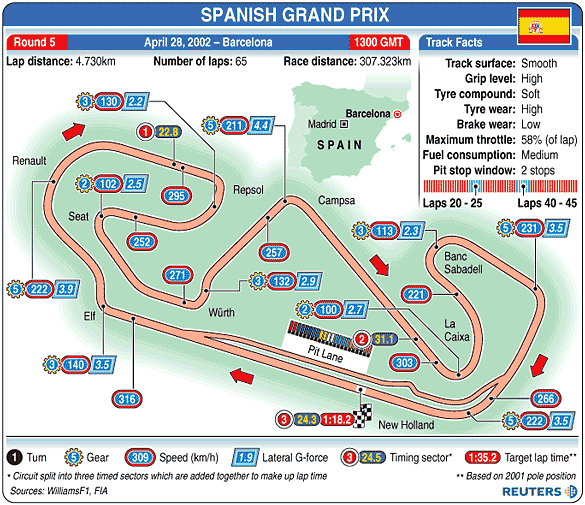
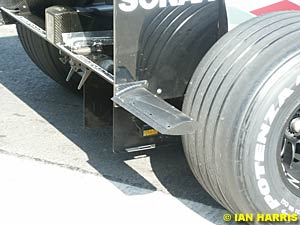 After Imola, Michelin motorsport director Pierre Dupasquier was worried by the pace of the new Ferrari on the fast sections on the Spanish circuit, stating that "in Barcelona, either the performance gap will be reduced and all the hard work we have done will help us take the battle to Ferrari, or the margin of superiority will remain unchanged and we will have to take an even harder look at what we are doing."
After Imola, Michelin motorsport director Pierre Dupasquier was worried by the pace of the new Ferrari on the fast sections on the Spanish circuit, stating that "in Barcelona, either the performance gap will be reduced and all the hard work we have done will help us take the battle to Ferrari, or the margin of superiority will remain unchanged and we will have to take an even harder look at what we are doing."
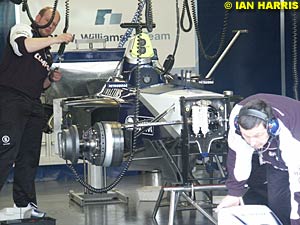 The team can expect to be more competitive in Spain, despite the set back in San Marino. The reliability and development of the car, plus the new Michelin tyres in a warmer climate, should bring them closer to Ferrari. Added to the team's excellent record at the start could get them ahead of the Ferraris and upset the Italian team's strategy.
The team can expect to be more competitive in Spain, despite the set back in San Marino. The reliability and development of the car, plus the new Michelin tyres in a warmer climate, should bring them closer to Ferrari. Added to the team's excellent record at the start could get them ahead of the Ferraris and upset the Italian team's strategy.
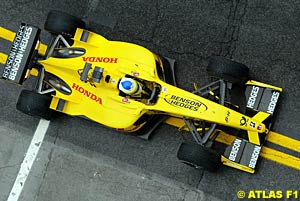 The team ran the small 'mid-wing' behind the cockpit as predicted throughout the weekend and in Silverstone testing - this year's version of the wing makes it a permanent part of the monocoque and not the removable engine cover, hence the device has to be used throughout a weekend, which in turn means the team has to run less rear wing to compensate. The test at Silverstone with both race drivers was aimed at reliability, tyres and brought a few small aero developments.
The team ran the small 'mid-wing' behind the cockpit as predicted throughout the weekend and in Silverstone testing - this year's version of the wing makes it a permanent part of the monocoque and not the removable engine cover, hence the device has to be used throughout a weekend, which in turn means the team has to run less rear wing to compensate. The test at Silverstone with both race drivers was aimed at reliability, tyres and brought a few small aero developments.
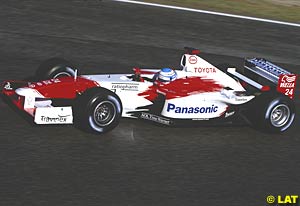 The all-new team has made a lot of progress this season, but Imola finally provided the team's first knock back. The wet Friday sessions gave away the lack of running the team have been able to complete in wet testing and the car's lack of mechanical grip.
The all-new team has made a lot of progress this season, but Imola finally provided the team's first knock back. The wet Friday sessions gave away the lack of running the team have been able to complete in wet testing and the car's lack of mechanical grip.
 At the wet opening sessions in Imola Mark Webber was able to show his pace in the updated Minardi. As the weekend wore on, the balance was restored in favour of the bigger teams and eventually Alex Yoong fell outside the 107% qualifying rule and failed to start the race. More fruits of the team's aerodynamic program under ex-Prost designer Loic Bigois appeared at San Marino. The usual pair of flip ups on the sidepods was supplemented by a third flip up mounted in between.
At the wet opening sessions in Imola Mark Webber was able to show his pace in the updated Minardi. As the weekend wore on, the balance was restored in favour of the bigger teams and eventually Alex Yoong fell outside the 107% qualifying rule and failed to start the race. More fruits of the team's aerodynamic program under ex-Prost designer Loic Bigois appeared at San Marino. The usual pair of flip ups on the sidepods was supplemented by a third flip up mounted in between.
Please Contact Us for permission to republish this or any other material from Atlas F1.
|
Volume 8, Issue 17
Atlas F1 Exclusive
Interview with Takuma Sato
Jo Ramirez: a Racing Man
Articles
Fisichella's Recurring Nightmare
Spanish GP Preview
Spanish GP Preview
Local History: Spanish GP
Facts, Stats & Memoirs
Columns
The Spanish GP Quiz
Bookworm Critique
Elsewhere in Racing
The Grapevine
> Homepage |